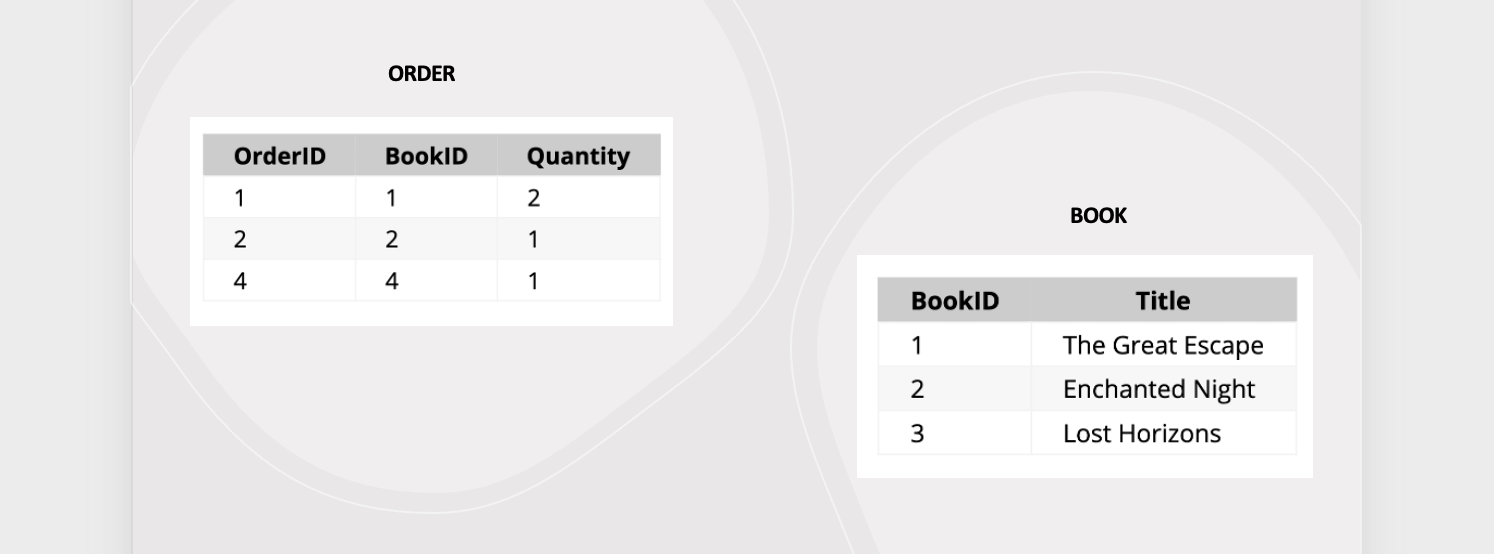Combining multiple tables
In our bookstore example, imagine we need to generate reports showing not just what books were sold, but also who bought them and when. We cannot achieve this only by focusing on just one Books table. We'll need to pull data from different tables to answer such complex questions.
Joins are crucial in relational databases because they allow for the combination of data from two or more tables based on a related column between them. This is essential for creating comprehensive datasets that can answer complex queries by pulling together relevant information from different tables.
Types of Joins
There are different ways we can join multiple tables depending on why we need those data in the other columns. For this lesson, we'll be looking at 4 different joins.
- Inner join
- Left outer join
- Right outer join
- Full outer join
To illustrate how these join work on multiple tables, let's consider two simplified tables from our bookstore database.

| OrderID | BookID | Quantity |
|---------|--------|----------|
| 1 | 1 | 2 |
| 2 | 2 | 1 |
| 4 | 4 | 1 | <-- Note: BookID 4 does not match any BookID in the Books table -->
1. INNER JOIN
This is the most common type of JOIN you'll come across. Inner join combines multiple tables by retrieving records that have matching values in both tables (in the common column). Following up with our bookstore example, let's look at how we can get data from both Orders and Books tables.
SQL Query:
SELECT Orders.OrderID, Books.Title, Orders.Quantity
FROM Orders
INNER JOIN Books ON Orders.BookID = Books.BookID;
Result:
| OrderID | Title | Quantity |
|---|---|---|
| 1 | The Great Escape | 2 |
| 2 | Enchanted Night | 1 |
2. LEFT OUTER JOIN
Also called LEFT JOIN, it returns all records from the left table, and the matching records from the right table. For the bookstore database, it'll return all rows from the left table (Orders), and the matched rows from the right table (Books). If there's no match, the result from the right table is NULL.
SQL Query:
SELECT Orders.OrderID, Books.Title, Orders.Quantity
FROM Orders
LEFT OUTER JOIN Books ON Orders.BookID = Books.BookID;
Result:
| OrderID | Title | Quantity |
|---------|------------------|----------|
| 1 | The Great Escape | 2 |
| 2 | Enchanted Night | 1 |
| 4 | NULL | 1 | <-- No matching _BookID_ in `Books` table for _OrderID_ 4 -->
3. RIGHT OUTER JOIN
This is the opposite of LEFT JOIN, where it returns all records from the right table, and the matching records from the left table. Using our example, it returns all rows from the right table (Books), and the matched rows from the left table (Orders). If there's no match, the result from the left table is NULL.
SQL Query:
SELECT Orders.OrderID, Books.Title, Orders.Quantity
FROM Books
LEFT OUTER JOIN Orders ON Books.BookID = Orders.BookID;
Result:
| OrderID | Title | Quantity |
|---------|------------------|----------|
| 1 | The Great Escape | 2 |
| 2 | Enchanted Night | 1 |
| NULL | Lost Horizons | NULL | <-- Note: No matching OrderID in Orders table -->
4. FULL OUTER JOIN
Combines the results of both LEFT OUTER JOIN and RIGHT OUTER JOIN. All rows from both tables are returned, with NULL values in places where there is no match.
SQL Query:
Result:
| OrderID | Title | Quantity |
|---------|------------------|----------|
| 1 | The Great Escape | 2 |
| 2 | Enchanted Night | 1 |
| 4 | NULL | 1 | <-- No matching BookID in Books table -->
| NULL | Lost Horizons | NULL | <-- No matching OrderID in Orders table -->
👩🏾🎨 Practice: Hypothetical Presidential Election
For a presidential election databse, imagine we have two tables: Candidates and Votes.
Task: Using JOIN, write the SQL commands to get an overview of the election results.
Candidates
| CandidateID | Name | Party |
|---|---|---|
| 1 | Jane K. Doe | Party A |
| 2 | John Smith | Party B |
Votes
| VoteID | CandidateID | Region | NumberOfVotes |
|---|---|---|---|
| 1 | 1 | North | 5000 |
| 2 | 2 | South | 4000 |
| 3 | 1 | East | 6000 |
| 4 | 2 | West | 3000 |